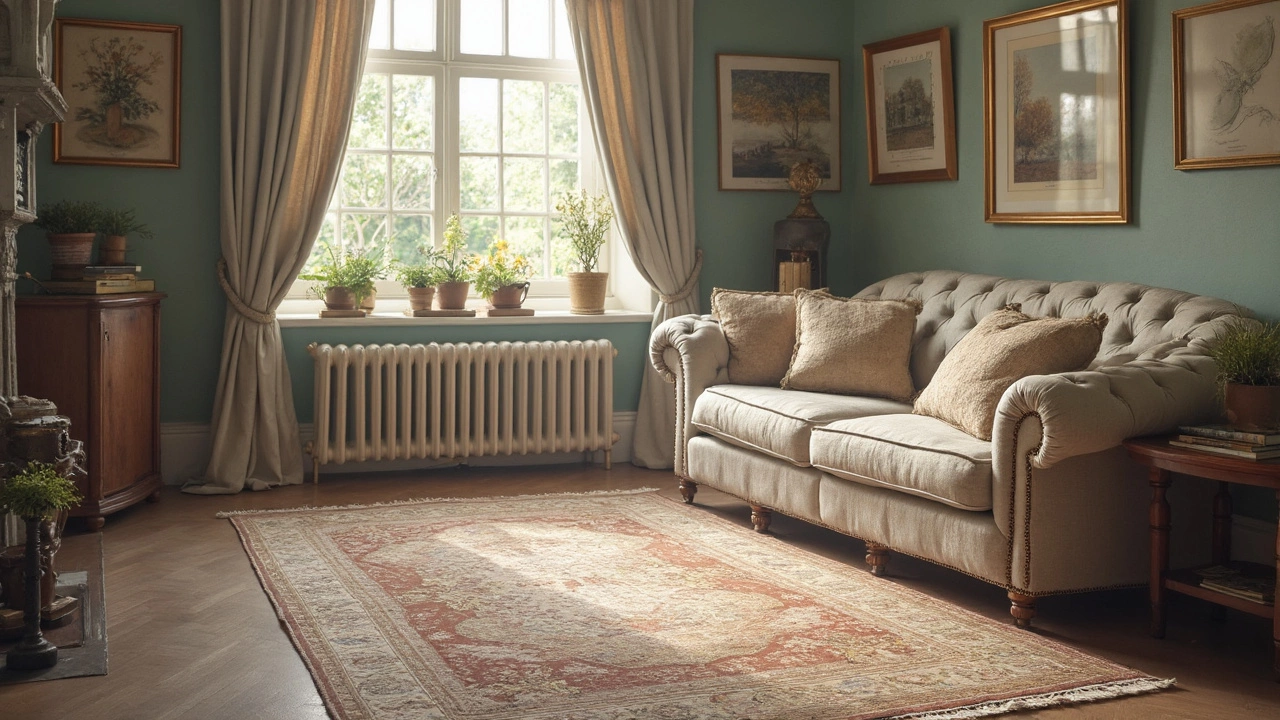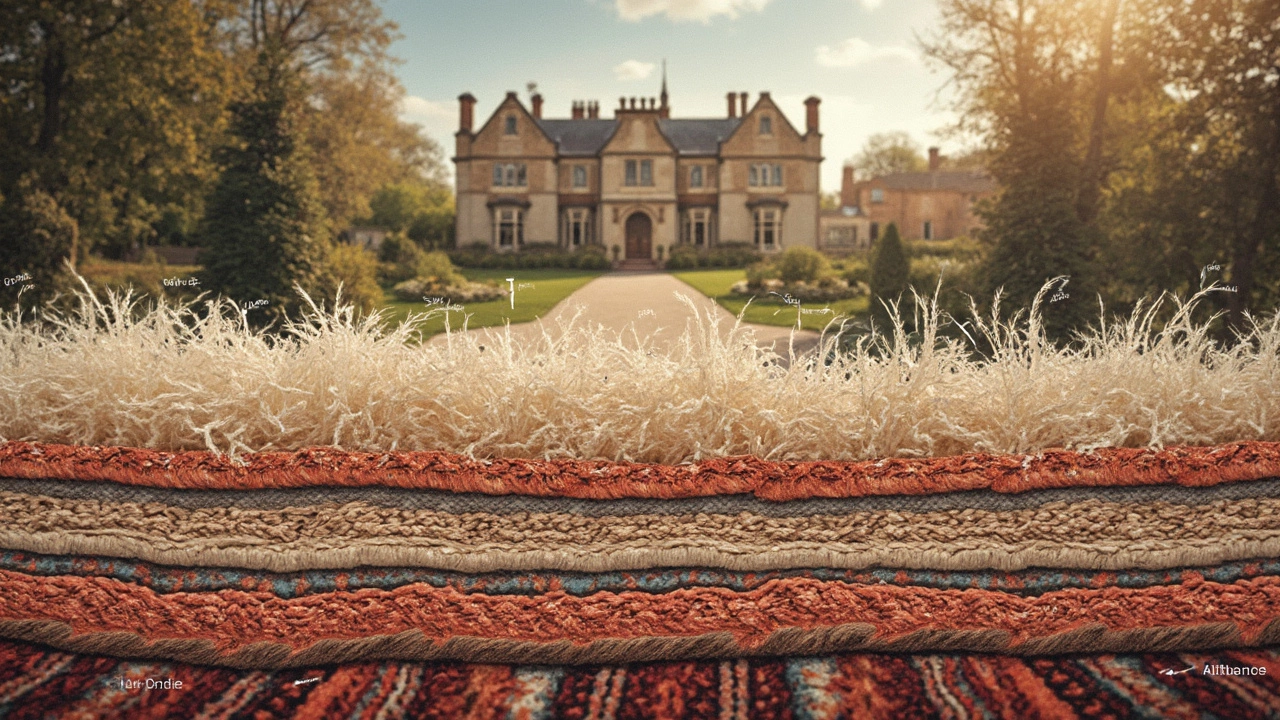Which Rugs Shed the Most? Unraveling the Truth
 Mar, 31 2025
Mar, 31 2025
Ever brought home a new rug, only to find your place looking like a furball festival? Yeah, you're not imagining it—some rugs really shed like they’re trying to be a pet. If you’re trying to figure out why this happens and how to avoid the mess, you're in the right place. Shedding can come down to the type of fiber and how the rug is made.
Let’s kick things off with natural fibers versus synthetics. Wool rugs, popular for their durability and comfort, are notorious for shedding, especially when new. However, as they age, they tend to calm down. Silk and cotton rugs also shed but are typically less offensive. On the flip side, synthetic materials like polypropylene or nylon usually shed less, making them a safer bet for shedding stress-free living.
- Why Do Rugs Shed?
- Natural Fibers vs. Synthetic: The Shedding Showdown
- The Weave Factor: How Construction Affects Shedding
- Top Rug Culprits: Which Ones Are the Worst?
- Tips to Minimize Rug Shedding
- Picking the Right Rug for You
Why Do Rugs Shed?
Got a shedding rug driving you nuts? Before you toss it out the door, let’s get into why this happens. The shedding game pretty much boils down to two main things: the rug’s material and how it's made.
First, let's talk fibers. Wool, a superstar in the rug world, is a culprit here. It sheds because loose fibers can get mixed in during the manufacturing process. Over time, as you walk on the rug, these strands come loose and end up all over your floor.
Now, consider the weave. Hand-tufted rugs are often the bad guys here. They’re created by punching strands through a canvas backing. Those tufts? They aren't as secure as you might like, which means more chance for shedding.
But don’t sweat it! Not all rugs shed equally. While natural fibers like wool, silk, and cotton tend to let loose more, synthetic rugs—made from things like nylon and polypropylene—are far less likely to lose their threads.
Oh, and one quick tip: rugs tend to shed more when they’re brand new. It’s often normal for the first few weeks, even months in some cases. So, if your new rug is leaving bits around, it might just be adjusting to its new home.
Natural Fibers vs. Synthetic: The Shedding Showdown
So, you're trying to dodge the dreaded dust bunnies made of rug fuzz, huh? The battle between natural fibers and synthetic materials is all about understanding what you're dealing with. Wool, a classic contender in the natural category, is loved for its warmth and comfort. But, it does have a shedding phase, especially in the first few months. Picture it like a puppy losing its baby fur—it calms down over time, but it can be a real pain while it lasts.
Besides wool, you’ve got materials like cotton and silk. Cotton rugs don't shed as much but can if they're not densely woven. Silk is luxurious and generally less of a shedder, but it can cost ya, both in price and upkeep.
Then there are the synthetic champs—polyester, nylon, and polypropylene. These guys are designed with the modern, busy bee in mind, being pretty much shedding-proof. They're like the teflon of the rug world, making them super practical for high-traffic areas or homes where you don’t want to spend time chasing fuzz balls around.
Here’s a sneaky trick: before you buy, check the back of the rug. Hand-knotted rugs typically shed less than tufted ones, where the fibers might not be as securely fastened. So if you’re after durability without the shedding hassle, that’s something to keep in your back pocket.
In summary, if you're shopping for low-maintenance, synthetic rugs might be your best friend. But, if you’re team natural and don’t mind some initial shedding for the sake of aesthetics, go for wool or silk. Just be ready for a bit of fuzz patrol duty at the beginning.
The Weave Factor: How Construction Affects Shedding
When it comes to shedding, how a rug is put together can make all the difference. Seriously, the way those fibers are woven can either make them stick around or go rogue all over your floor. Hand-knotted rugs, known for their craftsmanship, tend to shed less because those fibers are tucked in real tight. They're the Picasso of the rug world—not just a pretty face but functional too.
Tufted rugs, on the other hand, have a different story. During their creation, the fibers are usually glued into a cloth backing. Over time, this glue can break down, making these rugs shed more. According to interior designer Emily Reed, "
Tufted rugs are notorious for shedding, especially in high-traffic areas where the glue can wear down faster." Yup, choosing one could mean a relationship with your vacuum cleaner.
Want a less shedding-prone rug without spending a fortune on a hand-knotted masterpiece? Consider flat-weave rugs. They’re made without a pile and usually shed less because there's less to shed. These gems are great for those who want low maintenance but still stylish options.
- Knotted: Less shedding, higher cost.
- Tufted: More shedding, moderate cost.
- Flat-weave: Minimal shedding, budget-friendly.
So, when you're shopping, think about how the rug is made. It's not just about color or price. You've got to consider the rug materials and the construction if you don’t want your floor to look like a fur convention.

Top Rug Culprits: Which Ones Are the Worst?
When it comes to shedding, not all rugs play nice on your floors. Some types are really the worst offenders, leaving you wondering if you accidentally bought a pet instead of a rug. Knowing which ones love to shed can save you a ton of lint roller time.
First up, let’s talk about wool rugs. They’re super popular because they’re cozy and last forever, but man, they can shed like a boss, especially in the first few months. Over time, it usually gets better, but initially, don't be shocked if you’re sweeping up wool tumbleweeds on the regular.
Shag rugs are another repeat offender. You might love how fluffy they feel underfoot, but with their long fibers, they’re prime candidates for extreme shedding. It's like having a teddy bear that never stops molting.
Bamboo silk rugs might look high-end, but they’re sneaky shedders. While they add that luxe touch to your decor, they can leave you with more fluff than you bargained for.
There are also natural fiber options like jute or sisal rugs. They're rustic and cool but known to shed their fibers over time. These might not clog up your vacuum, but you'll spot those fibers slipping away bit by bit.
To save yourself the endless cleaning, go for low-pile or tightly-woven styles in the synthetic department. They’re not 100% shed-free but significantly less problematic.
Tips to Minimize Rug Shedding
Sick of feeling like you're living in a fur farm? While some shedding is unavoidable, there are a few handy tricks up your sleeve to stop your rug from becoming a hair factory and keep your home looking sharp.
The first rule of thumb is regular vacuuming. Sounds simple, right? But not just any old way will do. You need to vacuum your rugs gently and often, ideally every few days. Make sure to use the right setting for the rug type, because too much suction can do more harm than good, yanking out fibers and leaving more shed behind.
Ready for another tip? Try rotating your rugs every couple of months. This spreads out wear and tear, reducing pressure on certain areas. Over time, the fibers relax, and shedding often decreases.
Avoid harsh chemicals when cleaning. Use mild cleaners suited for the specific material of your rug. For natural fibers, a vinegar and water solution can be an eco-friendly and gentle alternative.
For new rugs, it's worth giving them a good shake before placing them down. This helps loosen excess fibers that were loosely attached during manufacturing. It's like prepping a new sweater before you wear it.
- Vacuum regularly but gently
- Rotate rugs to distribute wear evenly
- Use mild cleaners
- Shake out new rugs
By following these steps, you'll be able to keep shedding in check and enjoy your rug without the constant cleanup headache. Because let’s be real—nobody signed up for rug parenting duties.
Picking the Right Rug for You
Choosing the perfect rug feels like an adventure, right? With so many rugs out there, narrowing it down can be tricky—but let's make this easy! The type of rug you choose should depend on where it’s going and how much foot traffic it’ll face.
First thing’s first, think about the space. In high-traffic areas like the living room, you’ll want something durable. Synthetic materials like nylon or polypropylene are your friends here because they handle wear and tear without shedding too much. If you're eyeing a bedroom chill zone, a cozy wool rug might be perfect, just prepare for a bit of shedding at first.
Now, onto style! If vibrant patterns are your jam, wool or synthetic rugs offer a wide range without sacrificing quality. Remember to factor in maintenance. If you're not up for regular vacuuming, avoid high-pile options that hold onto dirt and dust. Low-pile rugs or flatweaves are easier to keep clean.
Let’s talk size. Make sure your rug fits the room scale—no floating carpets! In a living room, all furniture legs should ideally rest on the rug, while in the dining area, the rug should extend beyond the table to accommodate chairs.
Finally, here’s a nugget you might not often hear: consider allergies. Synthetic rugs are great for avoiding allergy flare-ups because they do not trap allergens as easily as natural fiber rugs. Sometimes less shedding is just about comfort and health.
So, keep these practical tips in mind and choose a rug that suits your life and style with minimal fuss. Happy decorating!